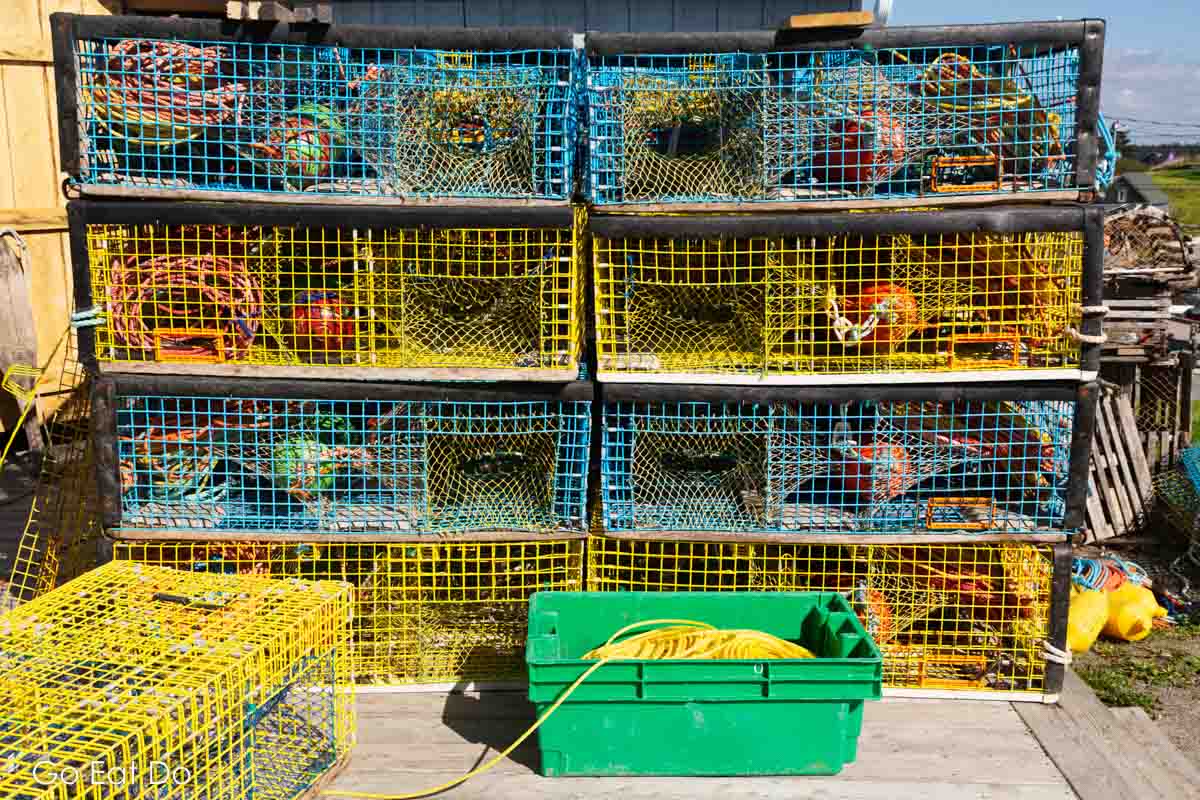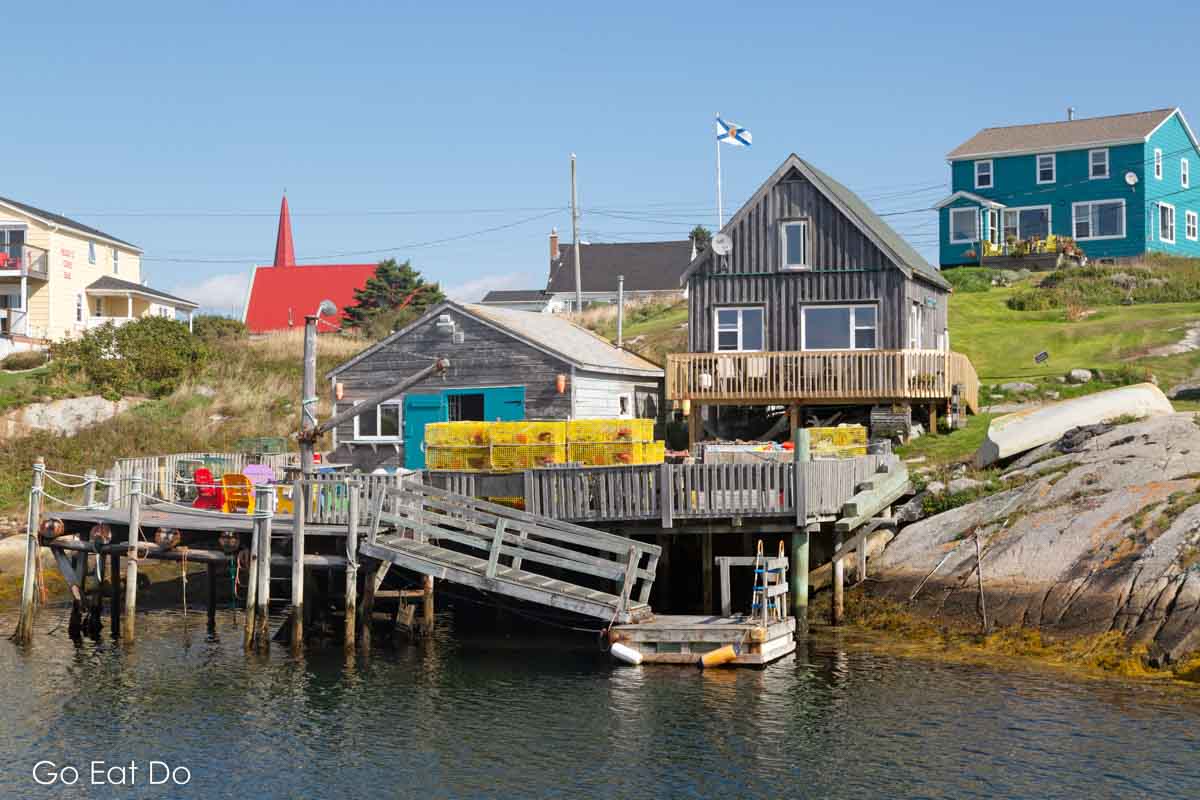Stuart Forster takes a scenic road trip in Canada exploring the Nova Scotia Lighthouse Route between Halifax and Yarmouth.
Some of the links and banners below are affiliate links, meaning, at no additional cost to you, I will earn a commission if you click through and make a purchase.
Washed by the white-capped waves of the unpredictable North Atlantic, Nova Scotia’s rugged coastline is at its most picturesque on warm summer days. It’s worth viewing at any time of year.
When the sun is shining, white-painted lighthouses that have long warned mariners against perils posed by sailing too close to shore stand in elegant contrast to the blue of the sky and ocean. This is all part of the scenic Lighthouse Route in Nova Scotia, Canada.

Lighthouse route in Novia Scotia
If you enjoy driving, you can view some of those lighthouses—for example at Peggy’s Point, Fort Point in Liverpool and Cape Forchu—while following the Lighthouse Route. The scenic driving route sweeps along Nova Scotia’s South Shore between Halifax and Yarmouth. The popular trail runs for 339 kilometres (211 miles).
Of course, you could cover that kind of distance in an afternoon, but some things are best enjoyed at a leisurely pace, particularly if you’re on vacation. The scenic route provides plenty of places for you to pull over, park up and photograph land- and seascapes.
After reaching Yarmouth you could always turn your vehicle around and head north-eastwards, back to Halifax.

Onto the Evangeline Trail
But if you have time available you’d do well to keep on motoring and loop around on the Evangeline Trail. It runs almost 300 kilometres (186 miles) from Yarmouth to Wolfville, skirting along the Bay of Fundy, before dropping southwards to Mount Uniacke, from there it’s an easy run into Halifax.
The Bay of Fundy is the location of the world’s highest tides. It experiences a maximum differential in sea level of more than 16 metres (53 feet) during the spring tide.
One of the best places to observe that natural phenomenon is in the woodland park by the lighthouse at Burntcoat Head. Stopping points along the route include the lighthouses at Masstown Market, Cape d’Or plus Cape George on the Northumberland Shore.
Travelling further east, to Cape Breton, will give you an opportunity to explore the lighthouse at Louisbourg. The destination is named after the Sun King, Louis XIV of France. It is famed for its reconstructed French-built fortress and historic town, founded in 1713.
Driving the Cabot Trail
If you enjoy being behind the steering wheel and the prospect of exploring another stretch of scenic coastal roadway appeals, then you shouldn’t miss the opportunity to drive the 298 kilometres (186 miles) of the Cabot Trail. The route, which is widely regarded as one of the world’s best scenic drives, also skirts through the Cape Breton Highlands National Park.
A peppering of car parks along the way means you can stop and walk on 26 different hiking trails. The seaside cliffs of the Cape Mabou Highlands and the ocean sunsets of the Skyline Trail are just two of many reasons why the Cabot Trail regularly draws comments of appreciation from travellers.

Arrival into Halifax
For much of this maritime province’s history visitors and settlers arrived after long transatlantic sea voyages rather than by air. Halifax’s Stanfield International Airport, named in honour of Robert Stanfield, a former Premier of Nova Scotia, is the chief port of entry into the province.
The harbour at Halifax, the Nova Scotian capital, is large, well-sheltered and deep. It remains ice-free in winter, a reason for the British settling and fortifying Citadel Hill in 1749.
The harbour opens out onto the Atlantic. During World War One it was of strategic importance to the Allied nations, who shipped munitions, essential supplies and even troops via the port. Georges Island, named after Great Britain’s King George II, is the site of Fort Charlotte, which bears the name of his queen, plus a lighthouse that was built in 1917.

Before driving the Nova Scotia Lighthouse Route
Before setting out from Halifax, onto the Nova Scotia Lighthouse Route, it’s worth taking time to visit the Canadian Museum of Immigration at Pier 21, where between 1928 and 1971 almost one million people, from around the world, took their first steps in Canada, the land that would become their home.
Stroll along the broad wooden boardwalk, at which ships used to moor to load and unload cargoes, and you can pop into the Maritime Museum of the Atlantic. The attraction conveys the importance of the sea and seafaring to Nova Scotia and its people. Samuel Cunard, the shipping magnate, was born in Halifax and became a catalyst in revolutionising transatlantic transport.
He saw how steam engines presented opportunities for regular sailing schedules, regardless of the prevailing wind conditions. The museum displays a deckchair and other telling artefacts from RMS Titanic, the supposedly unsinkable liner that plunged to the bottom of the Atlantic during her maiden voyage, after a collision with an iceberg in 1912.
Perhaps many other ships would have joined her on the bottom of the ocean if it wasn’t for the beams of light and warning tones of foghorns emitted from lighthouses along the Nova Scotian shoreline.

The lighthouse at Peggy’s Cove
The rustic village at Peggy’s Cove is one of the most popular stopping points on Nova Scotia’s Lighthouse Route, primarily because of its proximity to Halifax.

Photographers love the way the colourful houses and fishing boats reflect in the water of the cove. The lighthouse stands atop of rocks whose smooth surfaces have been rounded by centuries of winter winds and crashing waves.

The small town of Mahone Bay was once renowned for its shipbuilding but in recent years the craft stores have prompted many visitors to park up and take a stroll.
The sight of the town’s three waterfront places of worship—the St James Anglican Church, St John’s Evangelical Lutheran Church and Trinity United Church—is one of Atlantic Canada’s most iconic scenes. Locals swear it looks most spectacular on balmy autumn days when the foliage has turned yellow or red.

A Bluenose in Lunenburg
Pulling into Lunenburg means being able to stretch your legs in a fishing town with colourful façades. It was settled by German speakers in 1753.
A number of Georgian buildings still stand in the town, which has retained its grid pattern layout. As a consequence, UNESCO inscribed Lunenburg on its list of world heritage sites in 1995.
Look up and you’ll see protruding windows above the doorways of houses. The architectural feature, known as the Lunenburg bump, is a remnant of the time when women were reputed to have sat looking out, waiting for the return of their seafaring husbands.
The Fisheries Museum of the Atlantic stands by the wharf where the Bluenose schooner docked many times. Pick up a Canadian 10-cent piece and you’ll see the ship depicted on the coin’s reverse.

Liverpool and the Mersey
In common with its namesake in England, the River Mersey flows through Nova Scotia’s Liverpool. In Fort Point Lighthouse, which dates from 1855, you can learn how Liverpool was once a base for privateers—state-sponsored pirates—and look out into the harbour, towards the ominously named Coffin Island Lighthouse.
From there you can drive to Yarmouth to complete the Lighthouse Route. Cape Forchu Light Station, which today has a compact tea room, has cast its light since 1840 and stands 11 kilometres (7 miles) from the town. Samuel de Champlain, the man who has been described as ‘the father of new France’, named the rugged point Cape Forchu in 1604.
Like Champlain, lighthouses have their place in Nova Scotia’s history. Whichever route you choose to drive, the road back to Halifax promises to be scenic and will give you opportunities to explore more of the province’s maritime heritage.

Nova Scotia map
Zoom into the Google Map of Nova Scotia below to view details of the Lighthouse Route skirting the province’s South Shore:
Books about Nova Scotia
Planning on travelling to Nova Scotia? You can buy the following books from Amazon by clicking on the links or cover photos:
Lonely Planet guidebook to Nova Scotia, New Brunswick & Prince Edward Island:
Nova Scotia: Shaped by the Sea: A Living History by Lesley Choyce:
Fodor Travel’s Nova Scotia & Atlantic Canada guidebook:

Further information
Discover more about the province on the Nova Scotia website.
Take a look at the Explore Canada site for more ideas about Nova Scotia and the country as a whole including tips on Novia Scotia lighthouse accommodations.
Thank you for visiting Go Eat Do and reading this post about the Lighthouse Route in Nova Scotia. Interested in visiting the province? Search Go Eat Do for other features, including a post about exploring Nova Scotia beyond Halifax.
Photos illustrating this post are by Why Eye Photography.
If you enjoyed this post why not sign up for the free Go Eat Do newsletter? It’s a hassle-free way of getting links to posts on a monthly basis.
‘Like’ the Go Eat Do Facebook page to see more photos and content.
A version of this post was initially published on Go Eat Do on 4 February 2017.





Maddie Howe
June 28, 2018 at 01:20I so want to be driven along this trail. The photos look sooooooo beautiful!
Go Eat Do
July 10, 2022 at 11:55Thanks for your positive comment about the photos. It really is a beautiful Canadian road trip. Hopefully you get to experience the Lighthouse Route.
Lisa Wall
February 24, 2020 at 16:25I’ve just realised I did it in 1983. Sadly only took a couple of photos at Peggy’s Cove, which I now can’t find. I’ll have to go back
Stuart Forster
February 24, 2020 at 17:07Sounds like a good reason to do that!
Sarah
July 15, 2020 at 16:06Looks beautiful! Nova Scotia has been on my bucket list for awhile 🙂
Go Eat Do
July 17, 2020 at 17:37I rate it highly. I love visiting the province. Go there.